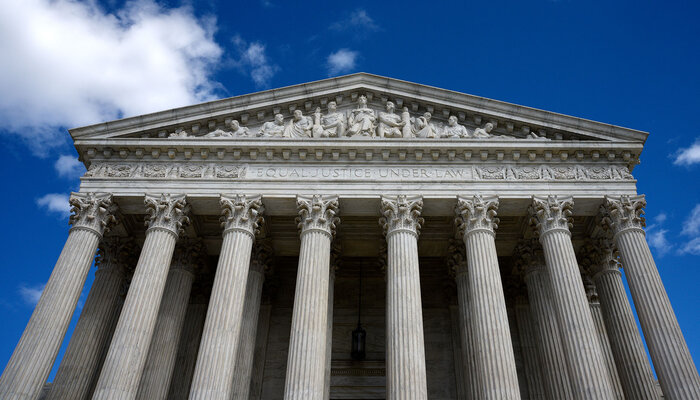
A Transformed Supreme Court Requires Different Solutions
The Court has changed substantially since the 19th century, and the tradition of life tenure should be viewed in this historical context.

Part of
Proposals for Supreme Court reform come in many forms, from expanding the number of justices, to restricting judicial jurisdiction, to implementing a code of conduct. Yet, increasingly, scholars and politicians from across the ideological spectrum have become interested in term limits as a practical method for constraining judicial power and mitigating the partisan nomination process.
Concerns about the Court’s power and partisanship are hardly new. Since the earliest years of the nation, political leaders pursued a variety of reform proposals designed to restrain the Supreme Court amid deep national ideological divisions. Even in an era when most did not believe in judicial supremacy — the idea that the Supreme Court has the final authority over the Constitution — Americans were skeptical of judicial power and quick to react if the justices appeared to overstep.
Amid the hundreds of Supreme Court reform bills proposed and passed by Congress in the 19th century, however, few featured term limits, and proposals that did limit judicial tenure were nearly always paired with other constraints. It was not that term limits were controversial. Instead, restricting a justice’s years on the bench simply was not an effective solution to the issues of power and partisanship as they operated in the 18th and 19th centuries. To understand why reformers so rarely proposed term limits is to understand just how dramatically the federal judiciary’s structure, staff, and role in American life have changed over the past hundred years.
The early Congresses designed and then expanded a system of federal courts that tied Supreme Court justices closely to the people. Beneath the Supreme Court, they created two tiers of lower federal courts — district courts and circuit courts — but only staffed district courts with judges. The intermediary circuit courts, by contrast, were not appointed a separate judge. Instead, each Supreme Court justice had an assigned circuit where he would spend a significant portion of the year “riding circuit,” traveling from courtroom to courtroom and acting as a circuit judge, paired with an appropriate district judge who would also assume these circuit duties.
Critically, this circuit system distributed the justices by geography: Americans expected members of the Supreme Court to be representatives (and residents) of the circuit over which they presided. That way, justices could accurately represent the law of their region in the nation’s capital and hold enough local clout to feel comfortable bringing the Court’s decisions to the people back home.
Judicial representation gave many parts of the country, particularly new states in the West, a voice in the growing nation. And while foreign to us today, circuit riding was incredibly popular in these states and beyond. The circuit-riding system lasted for 100 years because most Americans believed that the justices should interact with and be responsive to the people they were serving.
Although assignments were not always perfect, different regions of the country jealously protected their representation on the Court, insisting on the opportunity to fill an empty seat with a nominee from their circuit. Presidents operated under the assumption that their nominee would come from the vacant circuit and were careful to consult local and state political leaders in making an appropriate choice. The nomination typically did go to a partisan ally of the president, but importantly, it was primarily shaped by the political concerns of a particular region. If a hostile Senate rejected a judicial nominee, the next choice would still be made with input from political leaders of the circuit in question.
The Senate did, in fact, reject Supreme Court nominees for partisan reasons in the 19th century. Yet these rejections looked very different from our modern context — and not just because the early Senate did not hold public hearings. The overwhelming majority of nominees to the Court were active partisan politicians; these men were far more likely to have served in federal, state, and local offices or worked for partisan newspapers than to have experience as federal district judges. Typically, the nominee was well integrated into the circuit he would serve politically and had been recommended to the president for his political relationships, ideology, and acumen, not necessarily his legal abilities.
Most 19th-century justices also maintained some degree of political activity on the bench while insisting they could rule impartially in legal disputes. Justices’ activities ranged from writing presidential addresses, crafting legislation, and publishing newspaper op-eds (pseudonymously or otherwise), to hosting campaign activities and even running for political office themselves. Because nominees usually had long-standing partisan political careers both on and off the bench, a Senate majority was perfectly open in citing partisan reasons for rejecting a nomination.
The integrated relationship between partisan politics and the federal judicial system also made term limits an ill-fitting solution. Most Americans (and even the justices themselves) did not view the Supreme Court as the crown jewel of a long and distinguished judicial career in the same way we might today. There were plenty of reasons to turn down a seat on the Court or resign early. In addition to the position’s limited constitutional authority, nominees knew that circuit riding was onerous, particularly in the western states. Spending most of the year on the road took a significant physical toll on men who already possessed a shorter life expectancy than justices in the 21st century.
Even those who accepted a place on the Supreme Court might step down after a short time to pursue other political careers. And because empty seats on the Court were expected to be filled by someone from the assigned circuit, a shift in personnel might not make a substantial difference. Far more effective was a change in the allocation of the circuits to different regions of the country. (It is no surprise that the first major judiciary act passed by Republicans during the Civil War shrunk the number of Southern circuits.)
Methods for constraining the Court have changed in the modern era because the relationship between American politics and the federal judiciary has changed. Term limits would have done very little to address 19th-century concerns about power and partisanship. Understanding this history means recognizing how different our current judicial system is from the era of the founders and why different solutions might be necessary now with a Court that has accumulated more power than ever before.
Rachel A. Shelden is an associate professor of history and director of the Richards Civil War Era Center at Pennsylvania State University.
More from the Perspectives on Supreme Court Term Limits series
-
Why Term Limits for Supreme Court Justices Make Sense
Term limits are good policy and can be implemented by statute, a former federal appeals court judge explains. -
Life Tenure Is a Rarity on State Supreme Courts
The U.S. Supreme Court should follow the example of 49 states, where justices don’t serve life terms. -
The Constitution Allows for Term-Limited Supreme Court Justices
A former federal judge discusses how term limits for Supreme Court justices would afford them the same status and opportunities that retired justices and federal judges currently enjoy.




